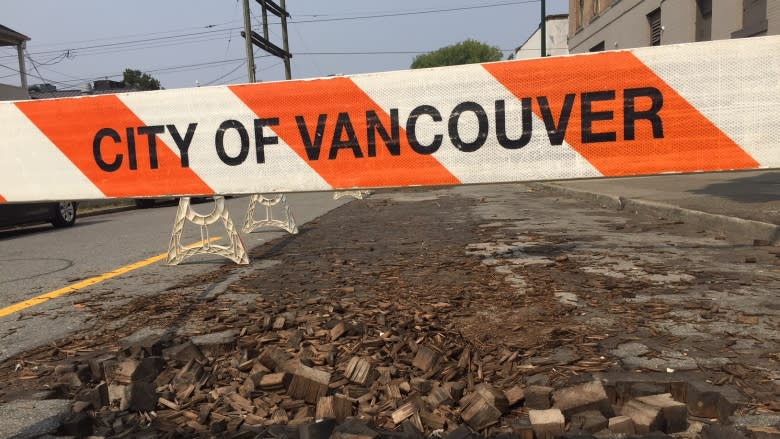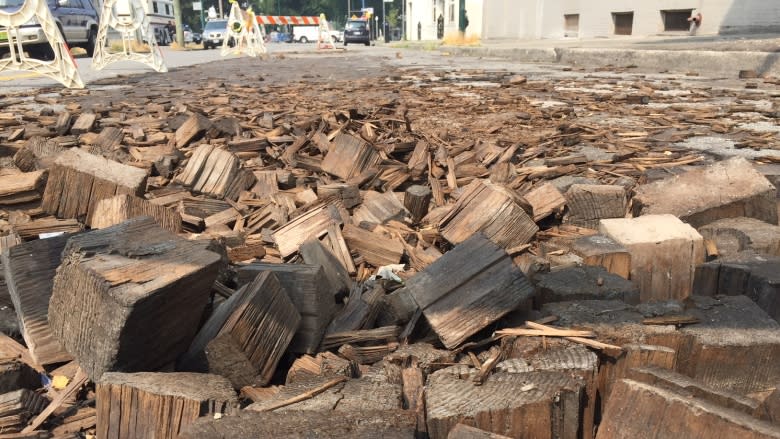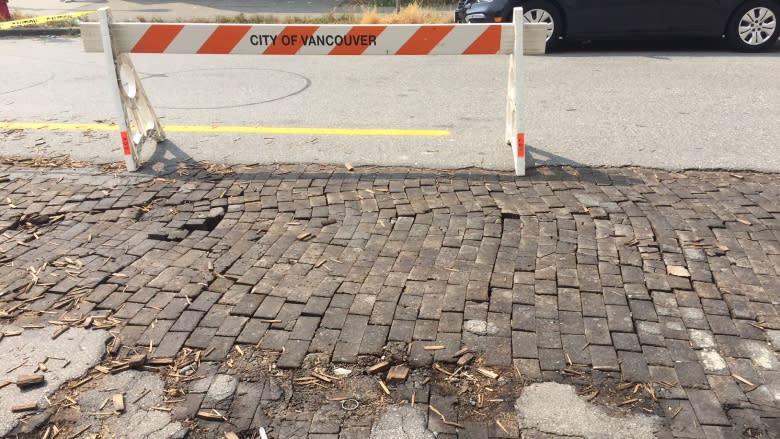Century-old wood used to pave early Vancouver splintering in heat
Hidden below the streets of downtown Vancouver, under decades of asphalt, there's a layer of history that reminds us how the City of Glass used to be built of wood — and paved with it too.
Cedar and Douglas fir, dipped in creosote or tar, were used to line core Vancouver streets in the city's early days.
Now, some of that wood — exposed after 100 years under hoofs, feet and tires — is splintering in the hot, dry weather and in need of repair.
But what looks like just another piece of summer roadwork is actually a fascinating window to a time in Vancouver when a skyscraper was 13 storeys and thousand-year old trees still grew in city limits.
"The forest resources here were just absolutely impossible to imagine," said civic historian John Atkin.
"The vista is so hard to comprehend."
'Slaughtered giants'
Viewed from 2018, a time when far-flung stands of old growth are tourist attractions, it's almost obscene to imagine the lumber cleared then from what's now the city centre.
Oxen hauled trees out of Kitsilano and the West End, dragging what a poetic 1912 correspondent for The Globe called "slaughtered giants of the ancient forest."
At first, huge planks were carved from those legendary trees to cover the city's streets, said Atkin, with Main Street (then Westminster) covered in boards that were each nearly a metre wide.
Then, end-grain wood blocks came into vogue, dipped in preservative and set like cobblestones in sand with a thin coating to protect the wood.
"Such a prepared surface of wood has greater endurance in resisting the mechanical forces of street traffic than the hardest paving-stones," wrote The New York Times in a 1868 editorial praising the wood block for Manhattan streets.
"There is no near approach to its excellence by any other kind of pavement in use here, and nothing superior elsewhere."
As early as 1890, a city engineer detailed a proposal to pay $3,960 for 198,000 cedar woodblocks to cover two blocks of Main, which would last 12 years.
Later that decade, a preserved map in the city archives shows the early extent of wood block paving in what was then a young city with mostly dirt roads.
The very core — including Granville in front of the first Hotel Vancouver — was bitumen, but just outside of that was wood.
"An incredibly efficient road surface," said Atkin about the wood blocks, especially in a city surrounded by lumber.
For decades, despite "newfangled ways of making roads, the woodblock was still the best and most long-lasting road surface possible," he said.
Over time, the wood stretched east, covering flat streets, said Atkin, while bricks and granite were used on hills so horses' hooves could get a grip.
"Almost all the streets east of Main Street ... to almost Commercial Drive, if you dug down on most of them you'd actually hit the wooden layer."
Wood block paving was still used until the early 1920s, when concrete and then asphalt took over, said Atkin.
But the blocks themselves have lasted underfoot much longer — precisely because they always had a protective coating, even before they were paved over.
"Wood blocks are kind of cool and everybody wants to see them, but they were never meant to be seen," he said.
"It was never meant to be exposed, and that's the biggest mistake."
Time to pave over
The patch of wood blocks needing repair is on Dunlevy Ave. at Hastings St., and has been exposed for at least a year and a half, if not longer.
Tightly-packed blocks have given way to loose and splintering chunks of wood. They may still have a whiff of cedar, though it's hard to be sure thanks to long-ago chemical preservatives and a hundred years of traffic.
The final straw? "Hot dry temperatures in the last few weeks," according to the city.
Vancouver isn't explicit about its plans, but is looking for "options to repair the road" without damaging the rest of the wood.
"As part of repairs, the remaining wood blocks will be paved over to prevent any public safety issues from exposed damaged wood," the city said in a statement.
So, this particular window to the past will be closing, sealed again underfoot.




